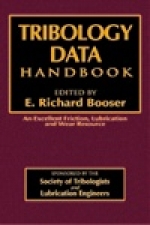Tab Article
Covers the entire field of tribology in one desktop reference
Features contributions from 74 experts
Includes hundreds of tables, equations, and figures
This handbook is a useful aid for anyone working to achieve more effective lubrication, better control of friction and wear, and a better understanding of the complex field of tribology. Developed in cooperation with the Society of Tribologists and Lubrication Engineers and containing contributions from 74 experts in the field, the Tribology Data Handbook covers properties of materials, lubricant viscosities, and design, friction and wear formulae.
The broad scope of this handbook includes military, industrial and automotive lubricant specifications; evolving areas of friction and wear; performance and design considerations for machine elements, computer storage units, and metal working; and more. Important guidelines for the monitoring, maintenance, and failure assessment of lubrication in automotive, industrial, and aircraft equipment are also included. Current environmental and toxicological concerns complete this one-stop reference.
With hundreds of figures, tables, and equations, as well as essential background information explaining the information presented, this is the only source you need to find virtually any tribology information.


